Liquid crystal on silicon (LCoS or LCOS) is a microdisplay technology that utilizes a liquid crystal layer on top of a silicon backplane. The technology, a kind of ‘spatial light modulator’, (SLM), provides high resolution, contrast, and black levels compared to competing technologies including liquid crystal display (LCD) and digital light processing (DLP). As there is an ever-growing demand for high-resolution displays, the LCoS segment of the market is projected to increase 32.25% CAGR through 2024.1
Any device that can control or change the amplitude, phase, or polarization of light waves is known as a Spatial Light Modulator (SLM). “Current SLM–based systems use either optical MEMS (micro-electromechanical system) or LCD technology.”2 LCD and LCoS displays function because liquid crystals can spin the polarization of light, with fluctuations in an electric field controlling the amount of crystal rotation, which decides the amount of light reaching the liquid crystal layer.
Primarily developed in the early 2000s for use in projection televisions, LCoS is now utilized in applications including near-eye displays, wavelength selective switching, structured illumination (e.g., beam shaping), and optical pulse shaping, among others.3 LCoS is the desired technology for augmented reality (AR) display devices, and has also embedded itself in the projector market, although there are a few differences in how the technology has been adjusted and configured for each type of application.
LCD, DLP, and LCoS Compared
To manufacture an LCD display, liquid crystals (one for each display pixel) are positioned on glass panels. “Light passes through these LCD panels on the way to the lens and is modulated by the liquid crystals as it passes. Thus, it is a ‘transmissive’ technology.”4
In comparison, a DLP display utilizes extremely small mirrors (one for each display pixel) to reflect light. The mirrors are tilted either into or away from the path of the lens to modulate the display image. Therefore, it is a ‘reflective’ technology. (The third type of technology is ‘emissive,’ meaning it produces its own light – for example, OLEDs and microLEDs.)
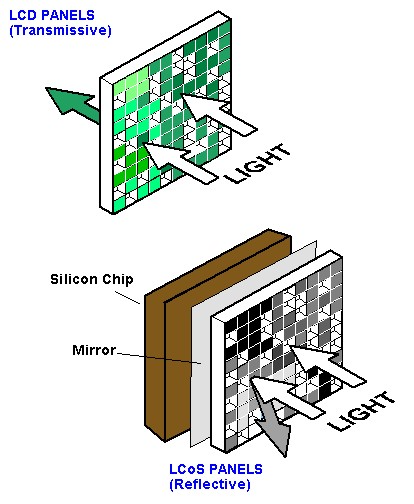
Transmissive LCD panels compared to reflective LCoS display panel technology. (Image: Source)
LCoS merges the approaches of transmissive and reflective technologies. Rather than individual mirrors, the reflective elements are the liquid crystals, “applied to a reflective mirror substrate. As the liquid crystals open and close, the light is either reflected from the mirror below, or blocked. This modulates the light and creates the image.”5
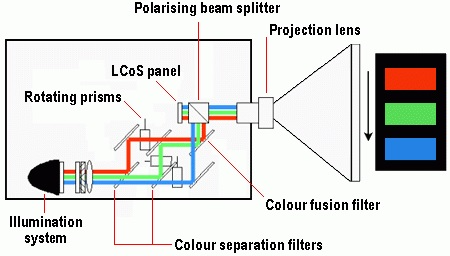
Simplified schematic of an LCoS projector system. (Image: Source)
To produce full-color images, LCoS displays and projectors generally utilize three LCoS chips: one each in the red, green, and blue channels (similar to how LCD projectors use three-color LCD panels). LCoS now dominates the market niche of “pico-projectors,” which are distinguished by their small size and low power consumption.6
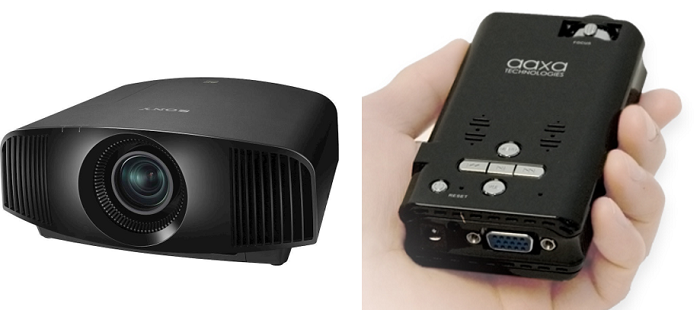
Sony’s 4K LCoS projector (left), marketed for home theater use (Image: © Sony Corporation of America), and the Aaxa P2 LCoS Pico Projector (right) (Image: © Aaxa Technologies).
LCoS Layers
LCoS microdisplays, such as those present in AR/VR devices, consist of a liquid crystal layer between one silicon semiconductor with a reflective (pixelated) surface and one transparent thin-film transistor (TFT). A light source, “shines through a polarizing filter and onto the device, and the liquid crystals act like gates or valves, controlling the amount of light that reaches the reflective surface. The more voltage a particular pixel's crystal receives, the more light the crystal allows to pass.”7
Typical component layers of an LCoS microdisplay are (bottom to top):
- Printed circuit board (PCB): the base of a display, which transmits instructions and electricity to the device
- Silicon (a chip or sensor): the silicon layer regulates the liquid crystal, typically with one transistor per pixel, making use of data from the device’s pixel drivers
- Reflective coating: reflects incoming light
- Liquid crystal: controls the amount of light that reaches the reflective coating and that is allowed back out
- Alignment layer: keeps the liquid crystals aligned correctly so they can accurately direct the light
- Transparent electrode: completes the circuit with the silicon and the liquid crystal
- Glass cover: Protects and seals the system8
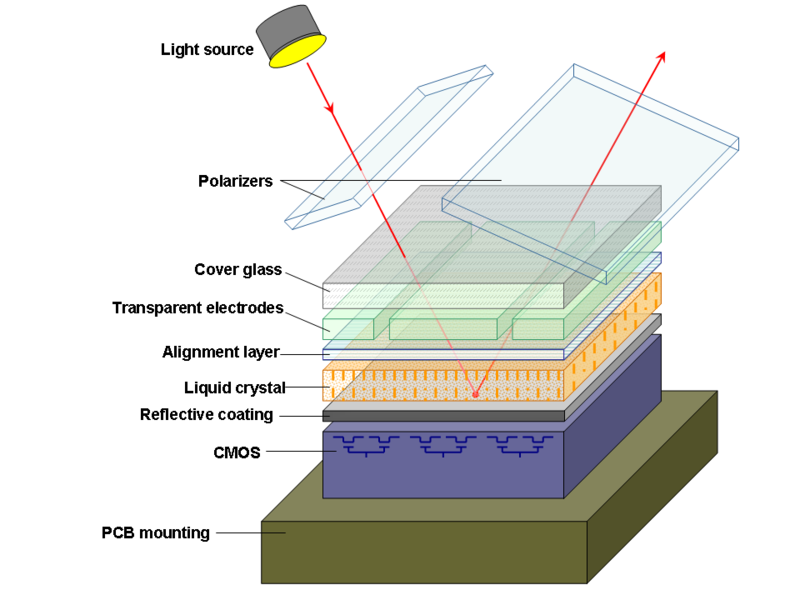
Layers of a typical LCoS microdisplay. (Image: Source, CC 3.0 Unported)
LCoS Applications
As a form of SLM, LCoS has a broad range of potential applications, including:
- Industrial projection (fringe/pattern projection – metrology, 3D-sensor, rapid prototyping, lithography)
- AR and VR applications
- Head-up displays (HUD) and head-mounted displays (HMD) in automotive, airborne, and defense industries
- Holographic projection and storage
- Industrial imaging (data displays, medical, simulation)
- High resolution non-direct view microdisplays, known as near-to-eye (NTE) systems. For example, some digital camera viewfinders (called electronic viewfinders, or EVF) systems
- Optical beam steering
- SLMs for R&D and phase applications.
LCoS microdisplays are particularly appealing for near-eye displays (NEDs) due to their high resolution, visual clarity, reduced energy use, and compact size. Interest in LCoS has been strong in the AR/VR industry, with consideration of both intensity-modulated and holographic-image-generation approaches.9 Projection-based systems such as automotive HUDs can also take advantage of the various benefits of LCoS.
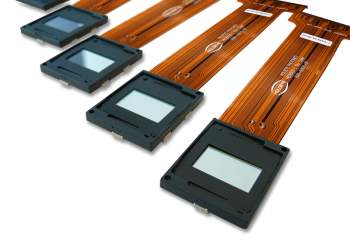
LCoS microdisplay components from Holoeye, ready for integration into virtually any type of product, from medical devices to aviation to consumer electronics. (Image © Holoeye)
Quality Control for LCoS and Other Display Types
As display technologies including microLED, OLED, and LCoS grow in popularity especially for use in AR/VR devices, and aerospace and automotive HUDs, particular attention will be required concerning careful measurement and testing procedures in order to ensure high-quality visual performance. Built around its high-resolution ProMetric® Imaging Photometers and Colorimeters, Radiant provides measurement solutions developed especially for these unique and novel applications.
AR/VR Devices
The Radiant Vision Systems AR/VR Lens system can accommodate for the novel viewing geometries of AR/VR devices including those with a front-located lens aperture. This allows for the positioning of the imaging system’s entrance pupil inside headsets and glasses at the same spot as a human eye. The system captures an entire display up to 120° horizontal in a single measurement due to the application of wide-field-of-view (FOV) optics.
In conjunction with Radiant’s TT-ARVR™ Software and a ProMetric imager, the AR/VR Lens allows developers and manufacturers of devices to assess key qualities in performance such as uniformity, color, brightness, contrast, and sharpness (MTF) of projected images.
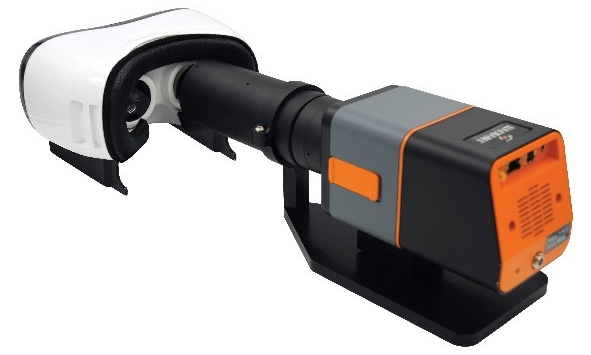
The AR/VR Lens replicates the position and size of the human pupil within a headset to capture the user’s full FOV. Image Credit: Radiant Vision Systems
Head-up Displays
HUDs present different measurement challenges that are significantly unique for various manufacturers, who must then take into account projected image luminance, contrast, and clarity irrespective of virtual image positions, ambient conditions, or focal distances on an infinite viewing plane. Extensive HUD testing demands the combination of both photometric (light data) and dimensional (spatial data) measurements to make sure the information transmitted to a vehicle operator within a fast-changing, real-world environment is accurate.
Radiant Vision Systems TT-HUD™ Software performs efficient light, color, and dimensional measurements with particular tests used to assess the quality of augmented projections, such as those emitted by HUD systems. A thorough HUD test solution from Radiant merges the TT-HUD software module with a ProMetric imager fitted with an electronically controlled lens to conduct high-speed, automated visual inspection. Tests range from distortion, MTF, ghosting, and eyebox analysis to brightness and contrast evaluation.
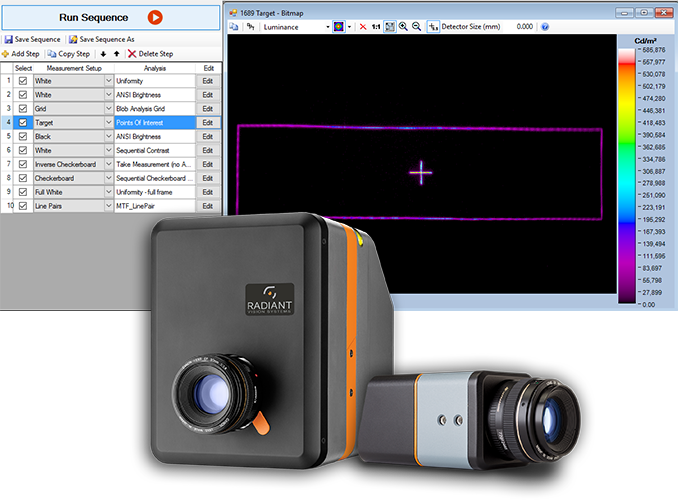
TT-HUD is used with a ProMetric Imaging Colorimeter or Photometer, providing multiple options to achieve the field of view, pixel resolution, and cost requirements for your application. Image Credit: Radiant Vision Systems
The TT-HUD solution can simultaneously test all HUD characteristics, processing the captured data much faster in a more consistent manner than a spot measurement device or machine vision system. Throughout an individual hardware/software solution, TT-HUD can be used to assess all visual aspects of the HUD system as well as test to exact parameters as recorded in automotive standards.

TT-HUD detects duplicate projections (overlapping or separated from the primary image) that are caused by ghosting effects using a Ghosting Analysis function. Image Credit: Radiant Vision Systems
References
- “Liquid Crystal on Silicon (LCos) Display Market – Growth, Trends, and Forecast (2019-20204)”, Research and Markets, June 20, 2019.
- Lazev, G., et al., “LCOS Spatial Light Modulators: Trends and Applications”, Chapter 1 in Optical Imaging and Metrology: Advanced Technologies, First Edition, Osten, W. and Reingand, N., editors. Wiley-VCH Verlag GmbH & CO KGaA: 2012
- “Liquid crystal on silicon”, Wikipedia. (Retrieved July 16, 2020)
- Powell, E., “What’s so hot about LCOS technology?”, Projector Central, July 18, 2003
- Pico Projectors Market – Forecast (2020 – 2025), Industry ARC. (Retrieved July 20, 2020)
- “Global LCOS Projector Market Insights, Forecast to 2025”, Industry Research, January 23, 2019.
- Wilson, T., “How LCoS Works”, How Stuff Works. (Retrieved July 16, 2020)
- Ibid.
- Huang, Y, et al., “Liquid Crystal on Silicon for Augmented Reality Displays,” Applied Sciences, Vol. 8, 2366. DOI 10.3990/app8122366
Acknowledgments
Produced from materials originally authored by Anne Corning from Radiant Vision Systems.
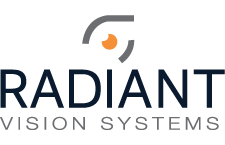
This information has been sourced, reviewed and adapted from materials provided by Radiant Vision Systems.
For more information on this source, please visit Radiant Vision Systems.